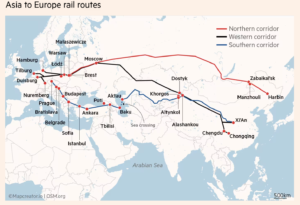March 12th, 2024
Courtesy of The Financial Times, an article on how demand to move goods from Asia to Europe by rail via Russia has increased since the start of the Red Sea crisis:
Demand to move goods from Asia to Europe by rail via Russia has soared since the start of the Red Sea crisis, according to logistics companies and rail operators, boosting the finances of the country’s state-owned rail monopoly.
Germany’s DHL said requests to transport goods on the Russian rail corridor had jumped about 40 per cent since container ships started diverting via a longer route in December. RailGate Europe said demand was up 25 to 35 per cent, while Netherlands-based Rail Bridge Cargo said cargo rail traffic via Russia this year was 31 per cent higher compared with the same time last year.
Logistics companies have looked anew at routes through Russia following the decision of most large container shipping lines to divert Asia to Europe sailings that would normally go through the Suez Canal to travel via the Cape of Good Hope. They acted after a campaign of attacks on commercial ships was launched by Yemen’s Iran-backed Houthis in support of Gaza’s Palestinians.
The diversions have pushed up door-to-door journey times between China and Northern Europe by seven to 10 days, to between 50 and 55 days. DHL said door-to-door journey times by rail through Russia between Chengdu in China and Duisburg in Germany were currently between 25 and 30 days.
“The requests have picked up since the beginning of the situation in the Red Sea by around 40 per cent,” DHL said of customer inquiries about rail. “The overwhelming amount is going through Russia.”
However, the company stressed that it was carrying no traffic originating in or travelling to Russia in line with western exports restrictions imposed on Russia for its war on Ukraine.
“We’re doing severe export controls, in line with applicable sanctions,” said DHL.
Logistics providers including Switzerland’s Kuehne & Nagel and Denmark’s Maersk said they had been avoiding using rail routes through Russia following Vladimir Putin’s full-scale invasion of Ukraine in February 2022. Monthly volumes on the route fell after the invasion and still represent less than the amount carried by a single large modern container ship.
RZD, which owns Russia’s vast rail network and operates most trains, is owned by the Russian state and has long been seen as closely connected to the Kremlin. The UK government described Oleg Belozyorov, the company’s chief executive, as having “close ties to Putin” when it imposed sanctions on him in April 2022.
Under EU sanctions, there is a near-ban on movements of road freight to and from Russia and Belarus. There are also restrictions on RZD’s ability to access some financial services. However, there is no ban on moving goods by rail through the country.
Figures from Eurasian Rail Alliance, a Russian company that organises freight movement on railways using Russia’s 1,520mm rail track gauge — wider than European tracks — show that container rail movements from China to Poland were 14,532 twenty-foot equivalent units (TEUs) of containers in January.
While the figure was 36 per cent above that for January 2023, it would not fill one of the largest modern container ships, which carry 24,000 TEUs each.
Michael Aldwell, head of sea logistics at Kuehne & Nagel, said there was “more demand” to move goods from Asia to Europe by rail under current circumstances.
“High-value cargo has always been popular [on that route],” said Aldwell.
Aldwell nevertheless stressed that Kuehne & Nagel, which used to offer a rail operation called KN Asia Express, had “completely” closed its operation on the route after the attack on Ukraine.
The majority of Asia to Europe goods go by rail travel on what DHL calls the “west corridor”, via Kazakhstan into Russia then into Belarus. Some traffic goes via a “north corridor”, crossing directly from China into Russia east of Mongolia.
Some logistics companies offer a “southern route” that avoids Russia, going via Kazakhstan, Azerbaijan and Turkey. But that route, which involves a ferry crossing of the Caspian Sea, takes longer than a container ship trip between China and Europe. It is viable mainly for goods going to and from central Asian countries such as Uzbekistan.
Maersk in September started offering customers the option to send goods by sea to the Georgian port of Poti and then onward to central Asia by the southern route.
Julija Š?iglait?, RailGate Europe’s head of business development, said her company had no dealings with RZD. It was instead booking traffic via operators such as Germany’s Deutsche Bahn.
Deutsche Bahn nevertheless confirmed that it currently acted only as a “travel agent” for goods going via Russia. RZD, which is owned by the Russian state, retains a near-monopoly over haulage of trains on Russia’s vast rail network. That means RZD will be paid both for hauling the goods through Russia and for access to its network.
Rail Bridge Cargo said its goods were “mostly” being hauled by RZD.
Focusing primarily on The New Seven Sisters - the largely state owned petroleum companies from the emerging world that have become key players in the oil & gas industry as identified by Carola Hoyos, Chief Energy Correspondent for The Financial Times - but spanning other nascent opportunities around the globe that may hold potential in the years ahead, Wildcats & Black Sheep is a place for the adventurous to contemplate & evaluate the emerging markets of tomorrow.

